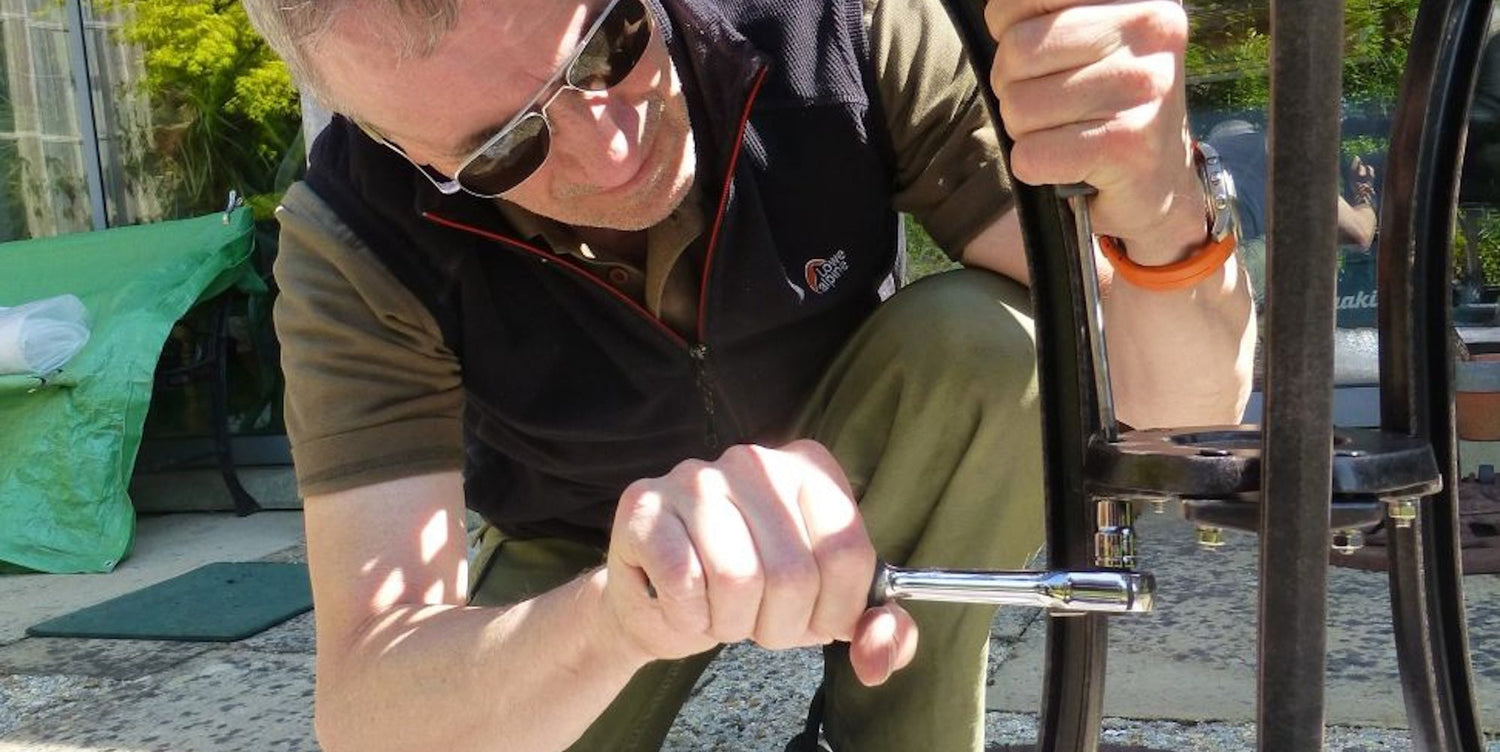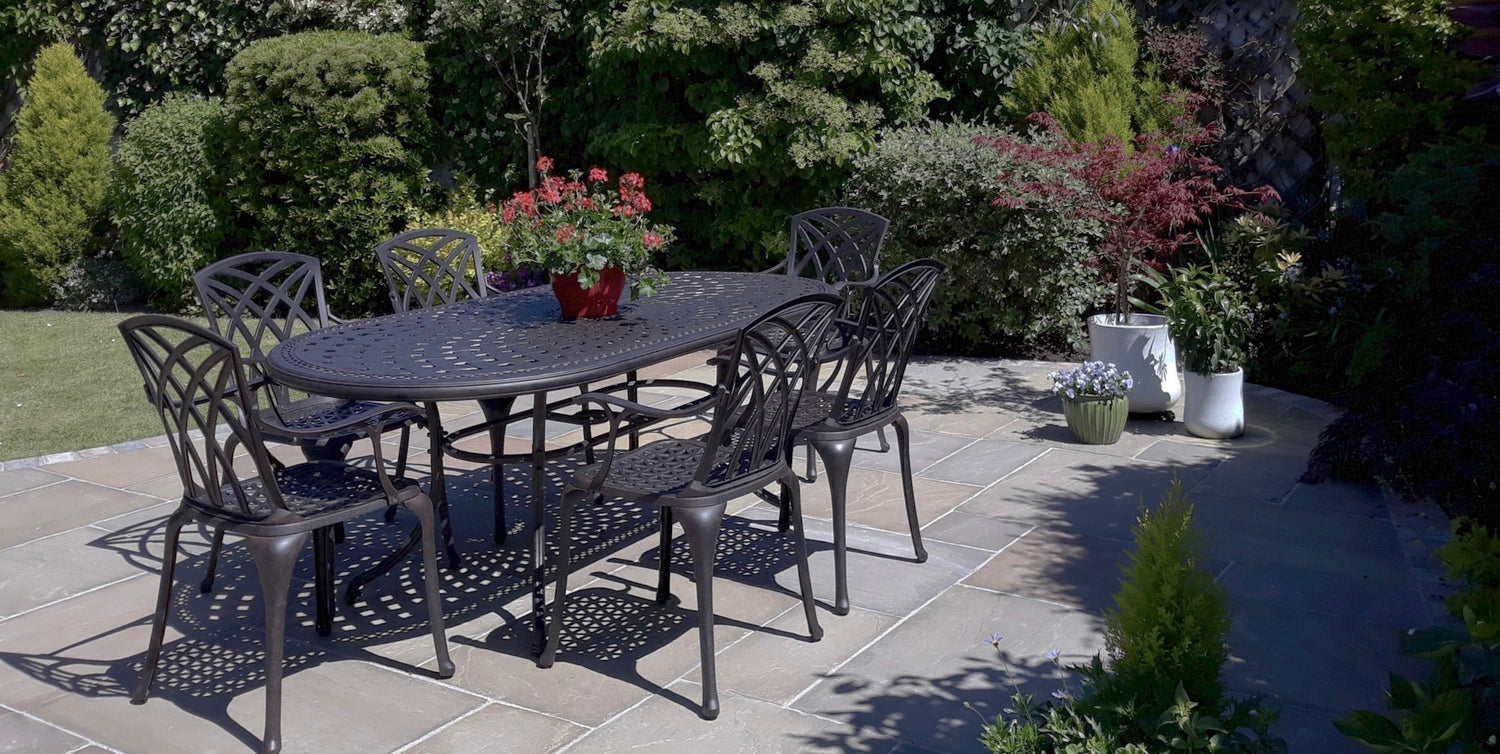Last month we asked if wood furniture needed to be sealed and we were keen to follow that post up and share some of the tips we’ve picked up to help keep outdoor wood furniture from rotting.
If you’ve invested money in a timber garden table set and then time in maintaining it, you want to protect it and reduce the need to re-seal or even replace it.
Why does wooden garden furniture rot?
Here at Lazy Susan, we don’t sell wood but we know it well and appreciate the natural beauty. What we offer is a material that requires significantly less maintenance but that we think delivers just as much classical patio style.
The inescapable fact is, that wooden garden furniture can rot, and this process is primarily due to the effects of moisture and microbial activity common in UK gardens.
If you want low maintenance, then a cast aluminium outdoor dining set from Lazy Susan is rust-resistant and features a durable powder-coated finish. We looked at the suitability of different materials to the UK climate in our what patio furniture materials are the most weather-resistant article.
However, if you have or want wooden furniture, and many do, then you have to be aware of the causes of rot and how best to prevent it!

The biggest culprit is moisture. Something we simply can't escape in the UK. Even in summer, we will see our fair share of precipitation. We are only a week or so into July and some parts of the UK have already had more rainfall than their full July average.
Wood is a porous material that absorbs water. Some timbers such as Teak and Cedar are less porous than others but they’re still susceptible if not properly maintained.
When wooden outdoor furniture is exposed to rain, humidity, or direct contact with wet ground, it can absorb moisture. Prolonged exposure to moisture will create an ideal environment for the growth of fungi and bacteria.
Wood-decaying fungi, such as those that cause white rot or brown rot, thrive in the UK’s moist but mild climate. They will break down the cellulose and lignin (a complex organic polymer that forms key structural material in wood), causing the wood to weaken and decay over time. The presence of fungi is often indicated by discolouration, a musty smell, and a softening of the wood.
Another common cause of rot in wooden furniture is pests such as wood-boring insects such as woodworms, who are attracted to damp wood and will burrow into it, causing significant structural damage. Their presence can be incredibly difficult to detect as they’re often only visible during the summer months.
What are the signs of rot to look out for on wooden garden furniture sets?
The biggest telltale sign that your outdoor furniture is rotting is discolouration. The wood will often change colour, becoming darker or showing patches of different shades. The feet are a common area where rot can take hold and the wood might also feel soft or spongy to the touch.
Visible growth of moulds or mildew on the surface of your furniture is another early sign of rot. As the wood weakens, it will often start to warp, crack, or split, recognising these early warning signs is crucial for maintaining the longevity of your patio furniture.
You can test your furniture by poking the surface with a screwdriver or a similar tool; if it sinks easily, the wood is likely rotting. If the rot is severe, then it will start to crumble or flake apart easily when touched, and sections of timber might need to be replaced.
How do you protect your wooden garden furniture from rot?

The good news is wood rot, with a little time and effort is easily prevented. Proper maintenance is critical. Sealing or treating the wood will eliminate the risk of decay in the rotting process. Protective coatings like varnish, paint, or sealant will help to create a barrier that protects against moisture.
Protecting wooden outdoor furniture from rot in the UK, where the climate can be quite damp and variable, requires a combination of preventive measures, regular maintenance, and proper storage practices.
Here are our top 10 most effective strategies that we have adopted in our gardens:
-
Material
Opt for naturally rot-resistant wood species such as Teak, Cedar, or Oak. They are more expensive but will last longer, If they are more than you are prepared to pay, then consider pressure-treated timbers, which are treated with preservatives to resist better rot and insect damage. We looked at the weather resistance of the common types of wooden garden furniture on sale in the UK in our How long will wood garden furniture last? Post. -
Style
Ensure that your furniture design allows water to drain off easily. Avoid designs that can trap water, leading to prolonged exposure to moisture. Curved slatted chairs and slatted table tops for example will prevent rainwater from pooling on the top surface. -
Protect
As advised by the retailer or manufacturer who you purchased the furniture from, use a suitable high-quality outdoor wood sealant, varnish, wax, oil, or paint to add a protective barrier against moisture. Reapply these treatments periodically, as recommended, typically every one to three years. Apply wood preservatives that will penetrate deeply into the grain and provide protection against rot, fungi, and insect damage. Our Does outdoor wood furniture need to be sealed? article looks at the reasons why, how to apply, and how to choose the right type of wood sealant. -
Maintain
By keeping your wooden garden furniture clean, you will remove the dirt, mould, and mildew that can build up and trap moisture. Avoid using harsh chemicals or pressure washers as they can damage the wood surface. A wash down with a sponge or soft bristle brush, warm soapy water (washing up liquid or a specialist wooden furniture cleaning solution), rinse and dry will suffice. Our How to clean and maintain wooden garden furniture article looks at how to clean and protect the popular types of wooden patio furniture on sale in the UK. -
Inspect
Regularly inspect your outdoor wooden furniture for any signs of damage, rot, or insect activity. Address any issues promptly to prevent further deterioration. If necessary, sand, repair and re-treat any areas that are showing signs of wear, peeling, or damage to maintain that all-important protective barrier. -
Cover
When not in use or when the weather takes a turn for the worst, cover your outdoor wooden furniture. Always use breathable, water-resistant covers to protect your furniture from rain and snow. Ensure covers can be securely fastened with straps or loops and that the fabric allows for air circulation to prevent moisture buildup. In our experience, individual covers for the table and each chair are easy to fit and less likely to come off if the wind picks up. -
Store
If possible, we would also recommend storing your wooden outdoor furniture in a dry, sheltered place like a garage or shed during the winter months if you can. If indoor storage is not an option due to space or weight, then as well as covering, elevate the furniture off the ground to prevent direct contact with wet surfaces. -
Position
Always place wooden furniture, even in summer, on a hard surface such as a patio, deck, or paving stones to avoid direct contact with moist soil and grass. Use furniture risers or feet to elevate the legs and allow for better air circulation. Ensure that the legs of the furniture do not sit directly on wet ground or in standing water for any period of time. -
Feet
Pay close attention to the feet of tables and chairs. If not positioned correctly, this is the point of contact with the ground, and where moisture can do the most damage. One way to prevent this is to install protective feet or furniture caps on the legs of chairs and tables to minimise contact with wet ground. -
Oil
Regularly apply furniture oil, such as teak oil or linseed oil, to nourish and protect the wood. This will help to maintain and enhance the natural appearance of the woodgrain and increase its resistance to UK rays and moisture ingress. Our Is it best to wax, oil, paint, or varnish garden furniture? post discusses what is best applied to different types of garden furniture.
By combining these methods, you can significantly extend the life of your wooden outdoor furniture and keep it looking good despite the challenging weather conditions we regularly see all year round in the UK.
![]()
Our final thoughts on wood garden furniture…
Regular attention and timely intervention are the keys to preventing rot and maintaining both the structural integrity and appearance of your wood furniture.
Here at Lazy Susan, contrary to what you may think, we love wooden garden furniture. You just have to be prepared to maintain it, and that is an investment of additional time and money that is not required for our cast aluminium outdoor furniture.
However, we have been in the outdoor furniture industry long enough to know that people tend to have a strong preference in terms of furniture style and material. If you are firmly in the wooden outdoor furniture camp, then we are probably not going to change your mind.
What we will say is that if you have wooden furniture in your outdoor space now or you’re researching the market and intending to buy it, understanding the signs of rot and how to prevent it is essential.
Look for timbers that have a higher resistance to rot and decay such as premium-end timbers like Teak, Ipe, Acacia, Eucalyptus or Oak. If they are a little out of budget, then there are several retailers in the UK selling pressure-treated wood or wood treated with preservatives that are more resistant to rot and therefore better suited to UK gardens.
The key, regardless of the type of wood, is always prevention. Follow our advice above. Regularly apply a teak oil, water-resistant sealant or paint to protect the wood from moisture. Avoid placing your wooden furniture directly on wet ground by using suitable risers, or protection or by placing it on a patio surface with adequate drainage.
In the off-season, store in a shed or garage if you can or use furniture covers during prolonged periods of rain or when the furniture is not in use. Clean the furniture regularly to remove dirt, mould, and mildew that can trap moisture.
If rot is detected early, it might be possible to repair the affected areas by removing the rotten wood and filling it with wood filler or epoxy. In more severe cases, replacing the damaged parts or the entire piece might be necessary.
However, by following our preventative measures and performing regular maintenance, you can extend the life of your wooden garden furniture and protect it from rot.
If you have photos of your Lazy Susan Outdoor Furniture, then we would love to see a few shots for our Do Some Good charity campaign. You can tag us @LazySusanFurniture on Instagram or Facebook or Upload Here.





